Alsatian dialect
Alsatian (Alsatian: Elsässisch or Elsässerditsch "Alsatian German"; Lorraine Franconian: Elsässerdeitsch; French: Alsacien; German: Elsässisch or Elsässerdeutsch) refers to the Alemannic German dialects spoken in most of Alsace, a formerly disputed region in eastern France that has passed between French and German control five times since 1681.
| Alsatian | |
|---|---|
| Elsässisch, Elsässerditsch | |
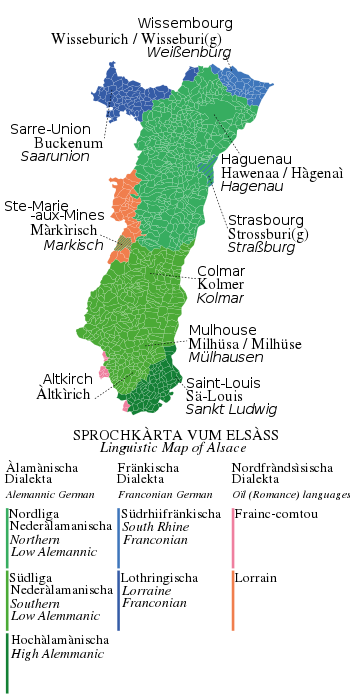 Linguistic Map of Alsace | |
| Native to | France |
| Region | Alsace |
Native speakers | 900,000 (2013)[1] |
Indo-European
| |
| Official status | |
Recognised minority language in | |
| Regulated by | No official regulation Officially promoted through the 'Office pour la Langue et les Cultures d’Alsace et de Moselle (OLCA)' (Office for the language and cultures of Alsace and Moselle), funded by the Grand Est region (formerly the Alsace region), and the departmental councils of Bas-Rhin and Haut-Rhin. |
| Language codes | |
| ISO 639-2 | gsw |
| ISO 639-3 | gsw (with Swiss German) |
| Glottolog | swis1247 Central Alemannic[2] |
| IETF | gsw-FR |
| Part of the series on |
| Alsace |
|---|
Rot un Wiss, traditional flag of Alsace |
|
|
|
|
|
Alsace in the European Union |
|
Related topics |
Language family
Alsatian is closely related to other nearby Alemannic dialects, such as Swiss German, Swabian, and Markgräflerisch as well as Kaiserstühlerisch. It is often confused with Lorraine Franconian, a more distantly related Franconian dialect spoken in the northwest corner of Alsace and in neighbouring Lorraine. Like other dialects and languages, Alsatian has also been influenced by outside sources. Words of Yiddish origin can be found in Alsatian, and modern conversational Alsatian includes adaptations of French words and English words, especially concerning new technologies.
Many speakers of Alsatian could, if necessary, write in reasonable standard German. For most this would be rare and confined to those who have learned German at school or through work. As with other dialects, various factors determine when, where, and with whom one might converse in Alsatian. Some dialect speakers are unwilling to speak standard German, at times, to certain outsiders and prefer to use French. In contrast, many people living near the border with Basel, Switzerland, will speak their dialect with a Swiss person from that area, as they are mutually intelligible for the most part; similar habits may apply to conversations with people of the nearby German Markgräflerland. Some street names in Alsace may use Alsatian spellings (they were formerly displayed only in French but are now bilingual in some places, especially Strasbourg and Mulhouse).
Speakers
Status of Alsatian in France
Since 1992, the constitution of the Fifth Republic states that French is the official language of the Republic. However, Alsatian, along with other regional languages, is recognized by the French government in the official list of languages of France. France is a signatory to the European Charter for Regional or Minority Languages but has never ratified the law and has not given regional languages the support that would be required by the charter. The policies of the Paris government have had the deliberate effect of greatly weakening the prevalence of native languages in France that are not "French." As a result, the Alsatian dialect of German has gone from being the prevalent language of the region to one in decline. A 1999 INSEE survey counted 548,000 adult speakers of Alsatian in France, making it the second most-spoken regional language in the country (after Occitan). Like all regional languages in France, however, the transmission of Alsatian is declining. While 43% of the adult population of Alsace speaks Alsatian, its use has been largely declining amongst the youngest generations.
A dialect of Alsatian German is spoken in the United States by a group known as the Swiss Amish, whose ancestors emigrated there in the middle of the 19th century. The approximately 7,000 speakers are located mainly in Allen County, Indiana, with "daughter settlements"[Note 1] elsewhere.[5]
Orthography
| Majuscule forms | |||||||||||||||||||||||||||||||
|---|---|---|---|---|---|---|---|---|---|---|---|---|---|---|---|---|---|---|---|---|---|---|---|---|---|---|---|---|---|---|---|
| A | B | C | D | E | F | G | H | I | J | K | L | M | N | O | P | Q | R | S | T | U | V | W | X | Y | Z | Ä | À | É | Ö | Ü | Ù |
| Minuscule forms | |||||||||||||||||||||||||||||||
| a | b | c | d | e | f | g | h | i | j | k | l | m | n | o | p | q | r | s | t | u | v | w | x | y | z | ä | à | é | ö | ü | ù |
| IPA | |||||||||||||||||||||||||||||||
| /a/, /ə/ | /b̥/ | /k/, /ɡ̊/ | /d̥/ | /e/, /eː/, /ə/ | /f/ | /ɡ̊/ | /h/ | /ɪ/ | /j/ | /k/ | /l/ | /m/ | /n/, /ŋ/ | /o/ | /p/ | /k/ | /ʁ/, /ʁ̞/, /ʀ/ | /s/ | /t/ | /ʊ/ | /v/, /f/ | /ʋ/, /v/ | /ks/ | /ʏ/, /yː/, /ɪ/, /iː/ | /z/ | /ɛ/ | /ɑ/, /ɑː/ | /ɛ/ | /œ/ | /y/ | /u/ |
C, Q, and X are only used in loanwords. Y is also used in native words, but is more common in loanwords.
Phonology
Consonants
Alsatian has a set of 19 consonants:
| Labial | Alveolar | Postalveolar | Palatal | Velar | Uvular | Glottal | |
|---|---|---|---|---|---|---|---|
| Nasal | m | n | ŋ | ||||
| Stop | b̥ | d̥ | ɡ̊, kʰ | ||||
| Affricate | pf | ts | tʃ | ||||
| Fricative | f, v | s | ʃ | ç | (x) | ʁ | h |
| Approximant | ʋ | l | j |
Three consonants are restricted in their distribution: /kʰ/ and /h/ only occur at the beginning of a word or morpheme, and then only if followed immediately by a vowel; /ŋ/ never occurs at the beginning of a word or morpheme.
Alsatian, like some German dialects, has lenited all obstruents but [k]. Its lenes are, however, voiceless as in all Southern German varieties. Therefore, they are here transcribed /b̥/, /d̥/, /ɡ̊/. Speakers of French tend to hear them as their /p, t, k/, which also are voiceless and unaspirated.
The phoneme /ç/ has a velar allophone [x] after back vowels (/u/, /o/, /ɔ/, and /a/ in those speakers who do not pronounce this as [æ]), and palatal [ç] elsewhere. In southern dialects, there is a tendency to pronounce it /x/ in all positions, and in Strasbourg the palatal allophone tends to conflate with the phoneme /ʃ/. A labiodental voiced fricative /v/ sound is also present as well as an approximant /ʋ/ sound. /ʁ/ may have phonetic realizations as [ʁ], [ʁ̞], and [ʀ].
Vowels
| Front | Central | Back | ||
|---|---|---|---|---|
| Close | i | y | u | |
| Near-close | ɪ | ʊ | ||
| Close-mid | e | ø | (ə) | o |
| Open-mid | ɛ | œ | ɔ | |
| Open | æ | a | ɑ ~ ɒ | |
Short vowels: /ʊ/, /o/, /ɒ/, /a/ ([æ] in Strasbourg), /ɛ/, /ɪ/, /i/, /y/.
Long vowels: /ʊː/, /oː/, /ɒː/, /aː/, /ɛː/, /eː/, /iː/, /yː/
Diphthongs
Grammar
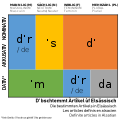 Declension of definite articles in Alsatian (all equivalent to English "the").
Declension of definite articles in Alsatian (all equivalent to English "the").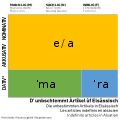 Declension of indefinite articles in Alsatian (all equivalent to English "a/an").
Declension of indefinite articles in Alsatian (all equivalent to English "a/an").
Alsatian nouns inflect by case, gender and number:
- Three cases: nominative, accusative, dative. Unlike Standard German, Alsatian does not have a genitive case, and, instead, utilises dative to fulfill that roles in certain cases.
- three genders: masculine, feminine and neuter.
- two numbers: singular and plural.
Comparative vocabulary list
| English | Southern Alsatian (Haut-Rhin) | Northern Alsatian (Bas-Rhin) | High Alemannic | Standard German | Swabian German | Luxembourgish | Standard French |
|---|---|---|---|---|---|---|---|
| house | 's Hüss | s' Hüs | Huus | Haus | Hous | Haus | maison |
| loud | lütt | lüt | luut | laut | lout | haart | bruyant |
| people | d' Litt | d' Lit | Lüt | Leute | Leid | Leit | gens/peuple |
| today | hìtt | hit | hüt | heute | heid | haut | aujourd'hui |
| beautiful | scheen | scheen | schö(n) | schön | sche | schéin | beau |
| Earth | d' Arda | d' Erd | Ärd(e) | Erde | Erd | Äerd | terre |
| Fog | d'r Nawel | de Näwwel | Näbel | Nebel | Nebl | Niwwel | brouillard |
| water | 's Wàsser | 's Wàsser | Wasser | Wasser | Wasser | Waasser | eau |
| man | d'r Mànn | de Mànn | Maa | Mann | Mà | Mann | homme |
| to eat | assa | esse | ässe | essen | essa | iessen | manger |
| to drink | trìnka | trinke | trinkche | trinken | trenka | drénken | boire |
| little | klei | klein/klaan/klëën | chl(e)i | klein | kloi | wéineg | petit, petite |
| child | 's Kìnd | 's Kind | Chind | Kind | Kind | Kand | enfant |
| day | d'r Tàg | de Dàà | Dag | Tag | Dàg | Dag | jour |
| woman | d' Fràui | d' Frau | Frou/Frau | Frau | Frau | Fra | femme |
See also
References
- Alsatian at Ethnologue (19th ed., 2016)
- Hammarström, Harald; Forkel, Robert; Haspelmath, Martin, eds. (2017). "Central Alemannic". Glottolog 3.0. Jena, Germany: Max Planck Institute for the Science of Human History.
- "Le dialecte en chiffres | www.OLCAlsace.org". www.olcalsace.org. Retrieved 2019-02-03.
- Denis, Marie-Noële (2003). "Le dialecte alsacien : état des lieux". Cairn.info.
- Chad Thompson: The Languages of the Amish of Allen County, Indiana: Multilingualism and Convergence, in Anthropological Linguistics, Vol. 36, No. 1 (Spring, 1994), pp. 69-91
- Marthe Philipp and Arlette Bothorel-Witz. 1990. Low Alemannic. In Charles V. J. Russ (ed.), The Dialects of modern German: a linguistic survey, 313–336. Routledge.
- (in French) François Héran, et al. (2002) "La Dynamique des langues en France au fil du XXe siècle". Population et sociétés 376, Ined.
- (in French) Le système ORTHAL 2016 – Orthographe alsacienne - Quelques règles de base pour faciliter l’écriture et la lecture de l’alsacien dans toutes ses variantes », Jérôme Do Bentzinger, 2016
- (in French) "L'Alsacien, deuxième langue régionale de France" Insee, Chiffres pour l'Alsace no. 12, December 2002
- (in French) Brunner, Jean-Jacques. L'Alsacien sans peine. ASSiMiL, 2001. ISBN 2-7005-0222-1
- (in French) Jung, Edmond. Grammaire de L'Alsacien. Dialecte de Strasbourg avec indications historiques. 1983. Straßburg: Ed. Oberlin.
- (in French) Laugel-Erny, Elsa. Cours d'alsacien. Les Editions du Quai, 1999.
- (in French) Matzen, Raymond, and Léon Daul. Wie Geht's ? Le Dialecte à la portée de tous La Nuée Bleue, 1999. ISBN 2-7165-0464-4
- (in French) Matzen, Raymond, and Léon Daul. Wie Steht's ? Lexiques alsacien et français, Variantes dialectales, Grammaire La Nuée Bleue, 2000. ISBN 2-7165-0525-X
- (in French) Steible, Lucie. Le contrôle temporel des consonnes occlusives de l’alsacien et du français parlé en Alsace. Linguistique. Université de Strasbourg, 2014.
External links
![]()
- 'Hover & Hear' Alsatian pronunciations, and compare with equivalents in English and other Germanic languages.
- Euromosaic: The status of Germanic languages in France (on website of Universitat Oberta de Catalunya).
- Alsatian placenames
- Wörterbuch der elsässischen Mundarten (in German)
- Alsatian artists
- Webschnuffler, article in the Frankfurter Allgemeine Zeitung on new versions of Microsoft programs in Alsatian (in German)
- Office pour la langue et les cultures d'Alsace et de Moselle (in French and German)
- Alsatian dictionary (in French) (in Alemannic German)
Notes
- ^ When Amish communities become too big, a number of families move away and form a new settlement, which is referred to as a daughter settlement. The settlement from which they leave is the mother settlement.[1][2]
- "Prince Edward Island Fever". ontariomennonitehistory.org. 8 February 2016. Retrieved 5 April 2018.
- http://thecommonlife.com.au/c/wp-content/uploads/2015/12/Let-Us-Reason-Together.wps_.pdf%5B%5D
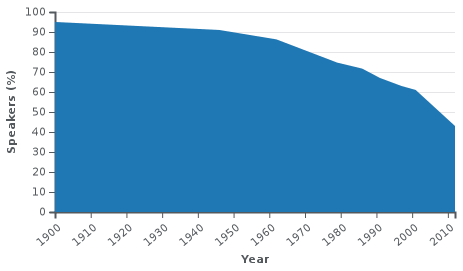
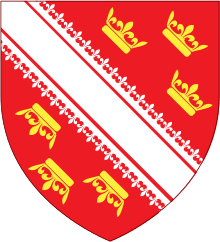
.svg.png)